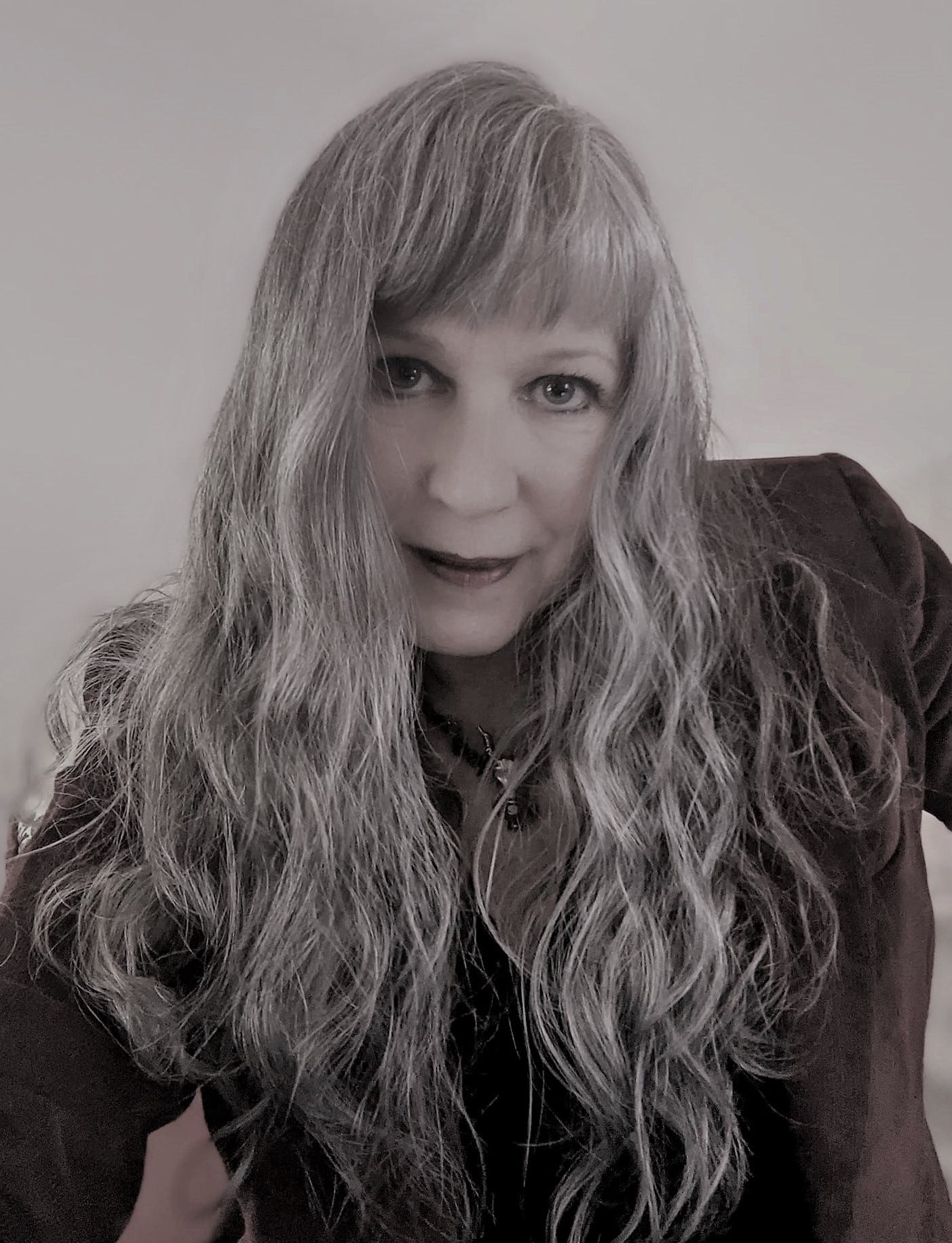Black screen, New Suns and Bluesky
Hello, my intelligent and curious friends. First of all… welcome new peeps!
Recently Substack notified me that they were offering a paid subscription to my most engaged free subscribers—a subscription that they (Substack) would cover the cost of. This is encouraging all around since it boosts the tiny perks I get from sandboxing my ideas here with you, and gives a bonus to those who are most interested in what unfolds here over time. It’s a capacity building strategy through generosity, and I’m grateful.
BLACK SCREEN (scream!)
Some weeks ago, the display unit on my four year-old space black laptop randomly space blacked out, never to be revived again no matter how much cursing and pleading I did to the quanta agents of the technoaether. The screen stayed indignantly void, with occasional magenta, white or green lines forming a shimmering LED tartan in one corner; this decorative fiasco is now in the shop being replaced, for what should be a criminally exorbitant fee. In the midst of this, I gave three online lectures, navigating the conundrum through use of two (dis)coordinated external monitors. At least two of three lectures went considerably well, with the third presenting a mortifying struggle—thankfully, this final talk was not public but delivered to my small, forgiving group of fellow members of the Art Research Ecology network.1
The first lecture was an artist talk that I did in dialogue with Dr. Amy Hale, hosted by Treadwell’s Books in London in partnership with the Museum of Witchcraft and Magic. Amy is an absolute delight—quick-witted, sensitive and inquisitive in the most disarming of ways, plus extremely knowledgeable about witchcraft and women’s occult art. If you aren’t familiar with Dr. Hale, she is the preeminent scholar on Ithell Colquhoun, the late British surrealist painter, occultist and author.2 It was a privilege to spend time with Amy discussing menstruation/blood in art and biotechnology through the lens of feminist witchcraft. It’s bolstering to have the opportunity to discuss shared interests with another scholar who has precise lived experience and an academic knowledge base to ask questions that challenge my thinking in the right ways. Also, there is a sophisticated craft in coaxing out particular areas of interest through discussion, in a manner that is assertively rigorous yet humble and empowering to the other person. Amy is a master of this craft, and her insights are delivered generously and respectfully.
The second lecture I gave was the inaugural Jake Stratton-Kent Memorial Lecture, hosted by the Museum of Witchcraft and Magic in partnership with Scarlet Imprint (the fiery intellects of Alkistis Dimech and Peter Grey). I cannot overstate the honour of being invited to deliver this talk with these folks, to launch the newly established JSK Memorial lecture series, part of an initiative that will eventually facilitate new space and new kinds of support for museum-hosted archival research projects.3 For all of my covenly compatriots interested in research involving rare books and occult archives: tuck that info away for later. The museum holdings are quite impressive and the museum intends to put significant effort into working with researchers to activate these holdings, all in the name of England’s “most notorious necromancer” (the late Jake Stratton-Kent himself).4
Part of my JSK lecture included reflections on my experiences of working within the tricksy, organic realm of the museum archive—a truly animated entity all its own. These will be elaborated in my forthcoming monograph, the launch of which is now pushed out until early 2025 (wee bit of a relief). BUT, if you want some related reading material right now, my annotated list of what was in the exhibition, and which served as the exhibition guide, is available as a downloadable PDF here. This guide was seemingly so alluring in its hand-bound version—crafted with red string by the meticulous museum administrator, Fergus Moffat—that one of the five copies mysteriously disappeared on the first day the museum/ exhibition opened. I hope that whomever decided they needed to possess it will endeavour to distribute it to another interested individual. I do love me a furtive network. However, I don’t love anything resembling plagiarism. I discovered online distribution of what seems to be uncredited (incredible!) synthesizing of research that I did on one of the rare works exclusive to the museum collection; it has been misattributed by someone with a popular (enough) Youtube channel, and the copyrighted imagery of the work used without the museum’s permission.5 My monograph, which includes accurately researched information about this exquisite work, will be published by the museum’s own Harbour Witch Imprint.
NEW SUNS
While one machine is being tinkered with by Apple-branded ‘geniuses,' I am busy tinkering with another: a 3D printer destined to be hacked into a retrofuturistic solar punk-style 3D bioprinter. Currently, it sits atop my kitchen counter next to the sink, one layer of gild adhesive painted over its plastic frame, waiting for me to add the copper leaf. I’m going for aged metal aesthetics, as if the apparatus is already decrepit in a speculative future world where custom bioprinting is commonplace. This is being developed as part of an artist residency I was recently selected to participate in at Artengine in Ottawa, called NEW SUNS.
New Suns is a collective “worldbuilding lab for radical futures,” facilitated by the really wonderful people at Artengine and under the guidance of Nigerian science fiction writer, Suyi Davies Okungbowa.6 The lab takes some of its inspiration from Octavia E. Butler’s work, especially the Parable series. So, too, does my contribution to the lab project: I’m building (hacking) a 3D bioprinter which I’ve named IMARA (a character from Butler’s unpublished/ unfinished Parable of the Trickster). Butler’s character, Imara, is the keeper of the ashes of Lauren, who was the founder of the revolutionary Earthseed movement, introduced in Parable of the Sower. Lauren, part poet, part survivalist, part visionary leads a self-organizing, not-so-merry band of dystopian refugees to a less volatile life whilst she is disabled by hyperempathy syndrome. Hyperempathy was a condition caused in utero by her mother’s abuse of a particular drug; it causes Lauren to feel all pain that she witnesses in others, sometimes even in more-than-human animals such as the feral dogs that populate Butler’s speculative fiction world. Possibly most interesting for me about Lauren’s condition is that it also caused her to physically bleed when she saw others bleed, until she experienced menarche. After that, she bled only for herself (though she still experienced others’ pain).
For my bioprinter, I will next try out DIY methods for tarnishing and/or creating patina on the copper leaf. After that, I will take it to the University of Ottawa Heart Institute, where I have been welcomed as a visiting artist-researcher in Dr. Emilio Alarcon’s lab. Here, his lab manager will oversee my fumbling through the process of assembling a new motherboard for the 3D printer, and installing it to run it as a bioprinter, with a new print head that can hold a syringe of bioink. Eventually, it will hold a syringe of bioink mixed with my cells. So, this project is being developed in tandem with Emilio’s lab and Artengine. I could elaborate further on what this project result will be, but I need to save it for a later post! For now, here are a few digital prototypes that I’m working from for developing my aesthetic aspect of the work:
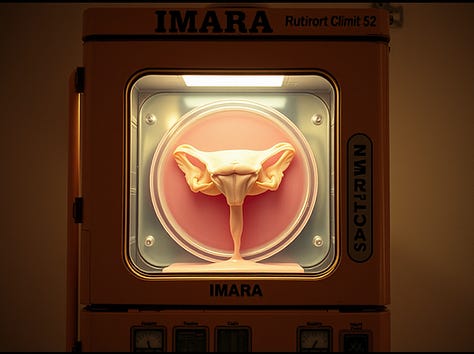
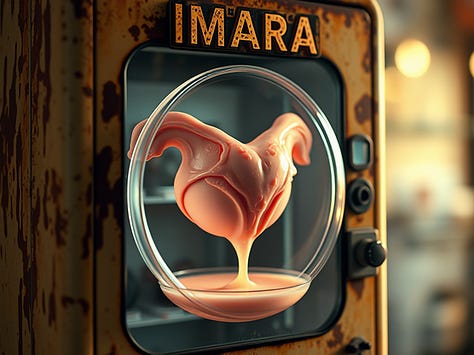

Here’s how my actual object is coming along so far (pre-patina):
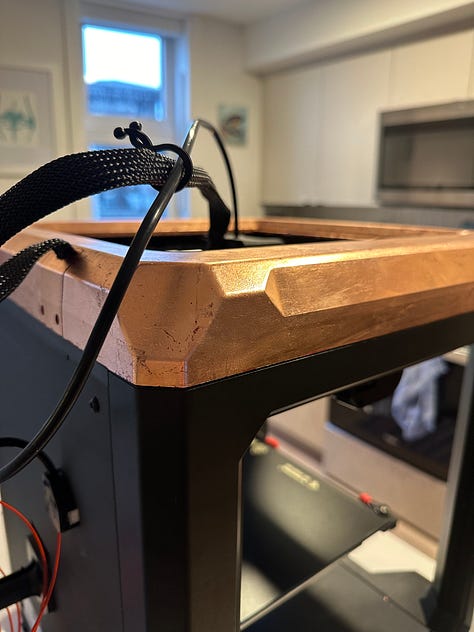

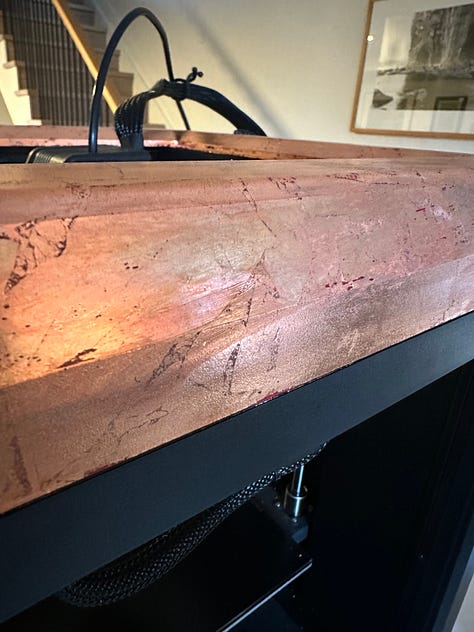
BLUESKY
I was on the crest of the wave of millions of people who recently migrated to Bluesky, the social media platform that has been gaining 1 million new users a day since the results of the US election (and subsequent X-odus).7 I stopped used X/itter over a decade ago because I found it overwhelmingly toxic even then, an experience much like bile rising in the throat. Bluesky, on the other hand, restores my faith in humanity a little (for now). The experience of Bluesky over the past week has felt like wandering into an open, sunny field of undiscovered delights, everyone blinking around at each other in amazement. That amazement, I feel, comes from the fact that a) there are no ads; b) the trolls have yet to amble in, still scouring the alleyways of X for the trusty cortisol fix; c) posts are delivered chronologically instead of consumed and regurgitated by an ad-motivated, negative engagement-enhancing algorithm. It’s almost a WYSIWYG setup in real time (with distributed moderators) and it’s the social media experience we all feel solastalgia for.
I immediately set up an Art + Science starter pack,8 with some major bioart and other techart bangers on the list, most of them from my in-person network. This starter pack is distinct from the others which focus on the proliferation of SciArt on the app—mostly science illustration, much offered as a commercial service within the realm of science communication. I’ve noticed that many of the SciArt people, who come from the sciences first and then develop painting skills to communicate sciencey topics, seem to be vehemently anti-AI. Related to this, I recently had a random Instagram follower leave a reactionary comment on my latest post of AI-rendered visual prototypes, saying “AI SUX,” etc. and making a half-baked environmental argument before unfollowing me in a huff. While I find it difficult to take comments like that seriously, I do consider my use of AI carefully in my own practice, and am transparent about it. I use it occasionally for generating visual prototypes that I intend to materialize in the real world. In this way, it’s like a sophisticated sketch tool. As for the enviro/ energy consumption angle, this is a bit of a sticking point when Meta platforms and cell phones have AI baked in to their operations—you can’t opt out, so if you’re a user of those, you’re a default user of AI. I applauded this Insta (un)follower for boosting the Meta algorithm with a negative comment. Engagement predictably went up.
Thus far, Bluesky is a veritable lovefest for intellectuals, there is some grace to it at present, and I’m truly enjoying the interactions with scientists, artists and other scholars without the outbursts that characterize other social media stages. Its more organic multi-feeds of various topics are giving me life. As the dreariness of autumnal drizzle, piercing air and shorter, darker days take over the immediate world I’m in, it is nice to see a little Bluesky right now. I’ve posed a question to the SciArt community on Bluesky about their views on the uses of AI, and I’ll report back on my findings. I trust there will be something of value to learn from them, because I’d rather collect first person data than just read a think piece. Always keeping it (kind and) personal, friends. I’m opening up comments to everyone on this post, so please feel free to share your thoughts. xx
Learn more about this fabulous group of researchers, organized by the lovely Anna and Finn Walker, here: https://are-research.com/
Please do go follow Dr. Amy Hale’s Substack, Chasing the Supersensual, here:
You can read more about this on the museum’s website here: https://museumofwitchcraftandmagic.co.uk/news/jsk2024/
Read more about this finest of fellows here: https://scarletimprint.com/jake-stratton-kent
Let’s hope this person corrects the information. I have contacted them and they do seem receptive.
You can read all about it here: https://artengine.ca/project/new-suns/
You can find me at whitefeatherhunter@bsky.social
You can check it out here: https://bsky.app/starter-pack/whitefeatherhunter.bsky.social/3lazdkmhvox2f





